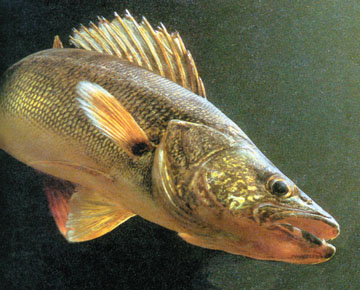
| Walleye Fishing Tips and Techniques:
Using light jigs with a white twistertail and a piece of worm, Walleye gullet, leech, live minnow or salted minnow works best. This is the most popular way to catch high numbers of Walleyes. |
Summer:
In the summer the walleyes go a little deeper, hang out at the mouth of rivers or lay off rocky points. Islands that have patches of gravel around them are good spots. Rocky drop-offs are also good. With lakes that have a flat structure, the Walleyes will head into the thick weeds to get protection from the sun.
In the summer, Walleyes tend to go after more natural colors like silver, brown, black and white. When fishing with jigs, you can go to a heavier jig like a 3/8-oz or even 1/4-oz depending on how deep you are fishing. The unscented twistertails or rubber you put on the jig should be these natural colors. Fish in the north do not like scented rubbers. They do like salted rubbers. Live minnows, if allowed, are excellent whether on a jig or just a strait hook. If you are on a lake where you cannot use live bait, get some salted minnows. We use to catch minnows and then cure them with salt. It seems a little cruel but it's convenient and the Walleyes go nuts over them. Just put a bunch of minnows on a cookie sheet and cover them with a generous amount of table salt.
Hot Days: Some times the Walleyes get very lazy in the summer, especially if it's a hot sunny day. Use a 1/8-oz jig and put a white unscented twistertail on. Then cast out and literally drag the jig across the bottom. Give it tiny little jigs (2 or 3 inches) once in a while just to shake off any mud or weeds. This bottom dragging gets the Walleyes feeding. It really works. You should always jig slowly. Just make the jig motion longer in the morning, as the Walleyes are more aggressive. Sharp quick jigs will attract pike. In the afternoon when the Walleyes slow down, put a piece of worm, Walleye gullet or salted minnow on your jig and use the slow bottom drag methed and you will start hitting Walleyes again.
Trolling off the rocky points is also good in the summer. Natural colors like silver or brown seem to work best. If you use bright colors, you will hit tons of pike. In the summer, the Walleyes tend to go a little deeper and stay off rocky points or rocky drop-offs because wave action on the rocks creates more oxygen. Also, bugs and other food floating on the surface tend to get more dense when drifting past a point so small minnows show up to feed and the Walleyes feed on the minnows.
Fall: Fishing in the fall for Walleyes can be very frustrating. What happens in many lakes is the water cools down and the weeds start to die. As the weeds die, they absorb oxygen out of the water as then decompose. Dead weeds also produce a dirty methane-sulfate and when the methane bubbles are released and float to the surface, the molecule capture a hydrogen molecule and releases the sulfur, which is poison to fish in high concentrations but with trace amounts, it's annoying to them. The Walleyes take off into open water or up rivers and away from the dying weeds. They may move to the outer edge of big weed beds where the prevailing winds are blowing fresh water into the weeds.
Rivers: The Walleyes will swim up stream and hang around deep pools or back moving currents on either side of a rapids. When fishing in a river for Walleyes, the best thing to use is a float with a minnow or a worm. You can cast and reel them in through the slower moving current and back-eddies. You can use jigs but you will get snagged many times and it can ruin your day.
Open Water: In the fall, many of the Walleyes go out into open water and stay suspended. Generally (not always) they tend to stay in 10 to 25 foot of water. Many fishermen like to troll. This is not the most exciting type of fishing but it's better then nothing. If you are in an area where there is a good population of Walleyes, you should catch them. You will need a depth finder and see where you are marking fish. The atmospheric pressure will effect what depth the Walleyes are at. If the pressure goes really low, the walleyes may stop feeding all together. BUT…if the pressure starts rising, the Walleyes will start feeding and aggressively. Walleyes always feed the best when the pressure is on the rise.





